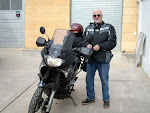 October 2nd:
October 2nd: Flight to Buenos Aires
Well I made it to B.A (just over 11 hours of flying). Groggy from no sleep, I arrive at the aeropuerto and passed through customs around 6:30 in the morning. I had been told by Mariano (of Motocare) that a taxi to their shop would cost about 30 dollars. Well at that time of the morning and in comatose conditions I ended up paying over 100.00 to a taxi driver in suit and tie. Go figure. I guess is should go well from here. How can I get taken any worse that that? I leave tomorrow morning (Saturday the 4th) The bike looks good and I'm loaded up and ready.
Buenos Aires, at least the part I'm staying in is rather different that I expected. Except for major streets, many intersections don't have street signs. The two taxis I've taken today both had problems finding the addresses given. We definitely should consider ourselves lucky to have basic things like stop signs or lights. Many intersections here have neither.
Mariano Calderon has been wonderful to rent the bike from. I'm sure he has his fingers crossed that I get the moto back in good condition. He has even loaned me a cell phone. Motocare has a very good web site: http://www.motocare.com.ar/rental
B.A to Villa Maria
Crossing Kansas? Long straight road with a brisk cross-wind. Lots of hawks of all things! Many hawks. I've never seen so many even when I've been training my homing pigeons at home I've never imagined these numbers. I estimate that I saw 40-50 today. About a third of all winged critters out there. Otherwise mostly cows and horses. Argentinians must love horses (I haven't seen any Gauchos however). Villa Maria is a rather large town. I needed help from the hotel staff to find my way out of the confusing downtown. Once again most intersection have no stop signs or street markers. Thank goodness the major ones do!
Villa Maria to San Miguel de Tucuman
Being the genius I am, I chose a route to Tucuman that by-passed another very large city and took me closer to the mountains. Well I saw the mountains off to the left as I again crossed Kansas. Absolutely straight and flat for about 250 miles then some rolling hills and more flat. Not particularly attractive part of Argentina.
This was a day of the "goat". Yep! By my estimate I saw over a thousand goats grazing by the highway. From 10 to 100 feet from the two lane blacktop were goats. Some groups were small, about 20-30 head while some groups were 75-100 in a single group. Oh and I saw a few sheep but very few horses and cows.
Route 9 took me straight to Tucuman. At about 4:30 I was tired and thought about getting lucky with finding a decent hotel somewhere in the coming miles. Sadly I think the "coming miles" were about 200! No town in that last half of the day was big enough to have a hotel. The towns reminded me of Central American villages with dirt roads and shacks. And dogs. When I finally arrived at about 7:00 it was getting dark and I drove about 3-4 miles through seriously impoverished (we call ghetto back home) area. I managed to ask two young guys on a moto if they would show me where there was a hotel and after abut two more miles of this huge city we arrived "downtown" Wow. The hotel is first class! I've never stayed in one this posh. I'm so tired I don't think I'll even "spell-check" Tomorrow will probably be a short day.
San Miguel de Tucuman to Jujuy
This day was as different as possible from yesterday. I leave Tucuman until around 10:00 after a visit to three banks. The first two wouldn't accept my ATM card that I got from AAA. I didn't have any problem with these cards in "06 through Central America but today. . . another element to the adventure. The ride to Jujuy was not straight and not flat. Mountains were just a few miles to my left for the majority of the trip. Although its early spring here, today was HOT. The first two days topped out about 65 degrees but today must have been 85. Jujuy like Tucuman was seeming endless streets without signs. I spent a half hour driving around looking for the "city center". And when I found it, it was awesome. Chaotic one-way streets without stop signs. Only on highways are there occasional stop lights. Not within the towns.
You really don't want to ride a motorcycle in cities like this. Maybe I'll get out tomorrow in one piece. Note: almost didn't get out with the motorcycle in one piece. The hotel had visitor parking in a space which amounted to a basement. The ramp going down was short and steep. I worried about getting back out and sure enough just as I got to the top of the ramp the bike died and fell over. It was still on an incline and it took four of us to get it up and ready to go. It didn't appear that anything other than the mirror being twisted and a couple of small scratches that the bike was hurt. Of course my pride was really hurt.
2. My Honda Transalp parked in front of a hotel. Most hotels, like this one, had secure parking.



















































